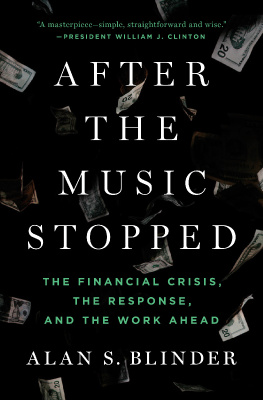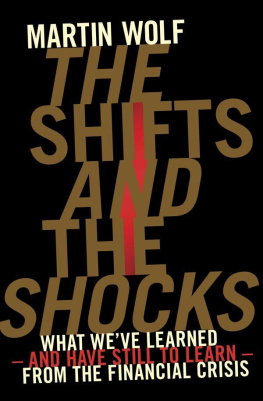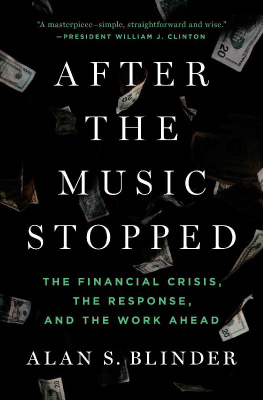Blinder - After the Music Stopped: The Financial Crisis, the Response, and the Work Ahead
Here you can read online Blinder - After the Music Stopped: The Financial Crisis, the Response, and the Work Ahead full text of the book (entire story) in english for free. Download pdf and epub, get meaning, cover and reviews about this ebook. year: 2013, publisher: Penguin Press;Penguin Group, USA, genre: Detective and thriller. Description of the work, (preface) as well as reviews are available. Best literature library LitArk.com created for fans of good reading and offers a wide selection of genres:
Romance novel
Science fiction
Adventure
Detective
Science
History
Home and family
Prose
Art
Politics
Computer
Non-fiction
Religion
Business
Children
Humor
Choose a favorite category and find really read worthwhile books. Enjoy immersion in the world of imagination, feel the emotions of the characters or learn something new for yourself, make an fascinating discovery.
- Book:After the Music Stopped: The Financial Crisis, the Response, and the Work Ahead
- Author:
- Publisher:Penguin Press;Penguin Group, USA
- Genre:
- Year:2013
- Rating:3 / 5
- Favourites:Add to favourites
- Your mark:
After the Music Stopped: The Financial Crisis, the Response, and the Work Ahead: summary, description and annotation
We offer to read an annotation, description, summary or preface (depends on what the author of the book "After the Music Stopped: The Financial Crisis, the Response, and the Work Ahead" wrote himself). If you haven't found the necessary information about the book — write in the comments, we will try to find it.
Many fine books on the financial crisis were first drafts of history--books written to fill the need for immediate understanding. Alan S. Blinder, esteemed Princeton professor, Wall Street Journal columnist, and former vice chairman of the Federal Reserve Board, held off, taking the time to understand the crisis and to think his way through to a truly comprehensive and coherent narrative of how the worst economic crisis in postwar American history happened, what the government did to fight it, and what we can do from here--mired as we still are in its wreckage.
With bracing clarity, Blinder shows us how the U.S. financial system, which had grown far too complex for its own good--and too unregulated for the public good--experienced a perfect storm beginning in 2007. Things started unraveling when the much-chronicled housing bubble burst, but the ensuing implosion of what Blinder calls the bond bubble was larger and more devastating. Some people think of the financial industry as a sideshow with little relevance to the real economy--where the jobs, factories, and shops are. But finance is more like the circulatory system of the economic body: if the blood stops flowing, the body goes into cardiac arrest. When Americas financial structure crumbled, the damage proved to be not only deep, but wide. It took the crisis for the world to discover, to its horror, just how truly interconnected--and fragile--the global financial system is. Some observers argue that large global forces were the major culprits of the crisis. Blinder disagrees, arguing that the problem started in the U.S. and was pushed abroad, as complex, opaque, and overrated investment products were exported to a hungry world, which was nearly poisoned by them.
The second part of the story explains how American and international government intervention kept us from a total meltdown. Many of the U.S. governments actions, particularly the Feds, were previously unimaginable. And to an amazing--and certainly misunderstood--extent, they worked. The worst did not happen. Blinder offers clear-eyed answers to the questions still before us, even if some of the choices ahead are as divisive as they are unavoidable. After the Music Stopped is an essential history that we cannot afford to forget, because one thing history teaches is that it will happen again.
Blinder: author's other books
Who wrote After the Music Stopped: The Financial Crisis, the Response, and the Work Ahead? Find out the surname, the name of the author of the book and a list of all author's works by series.







